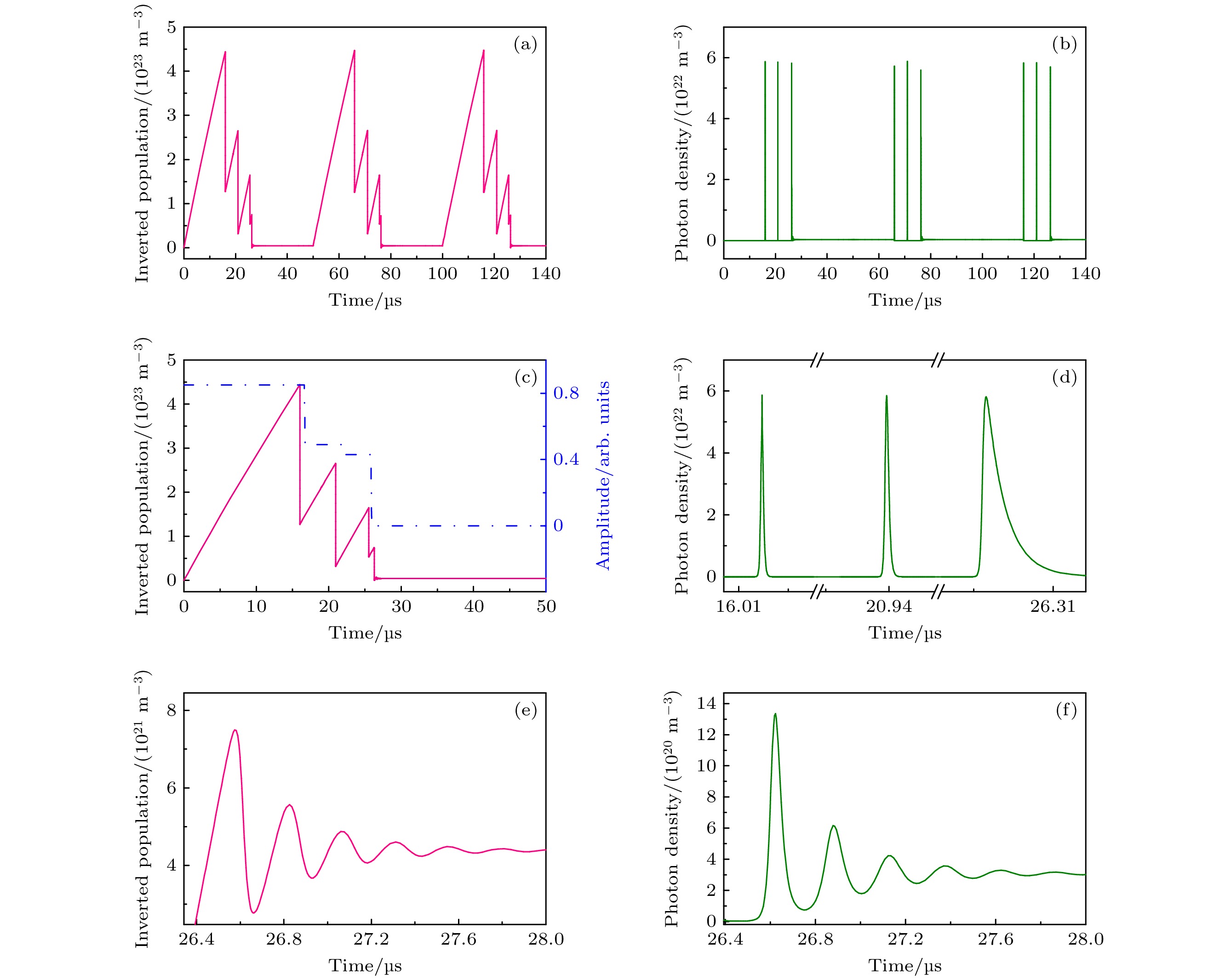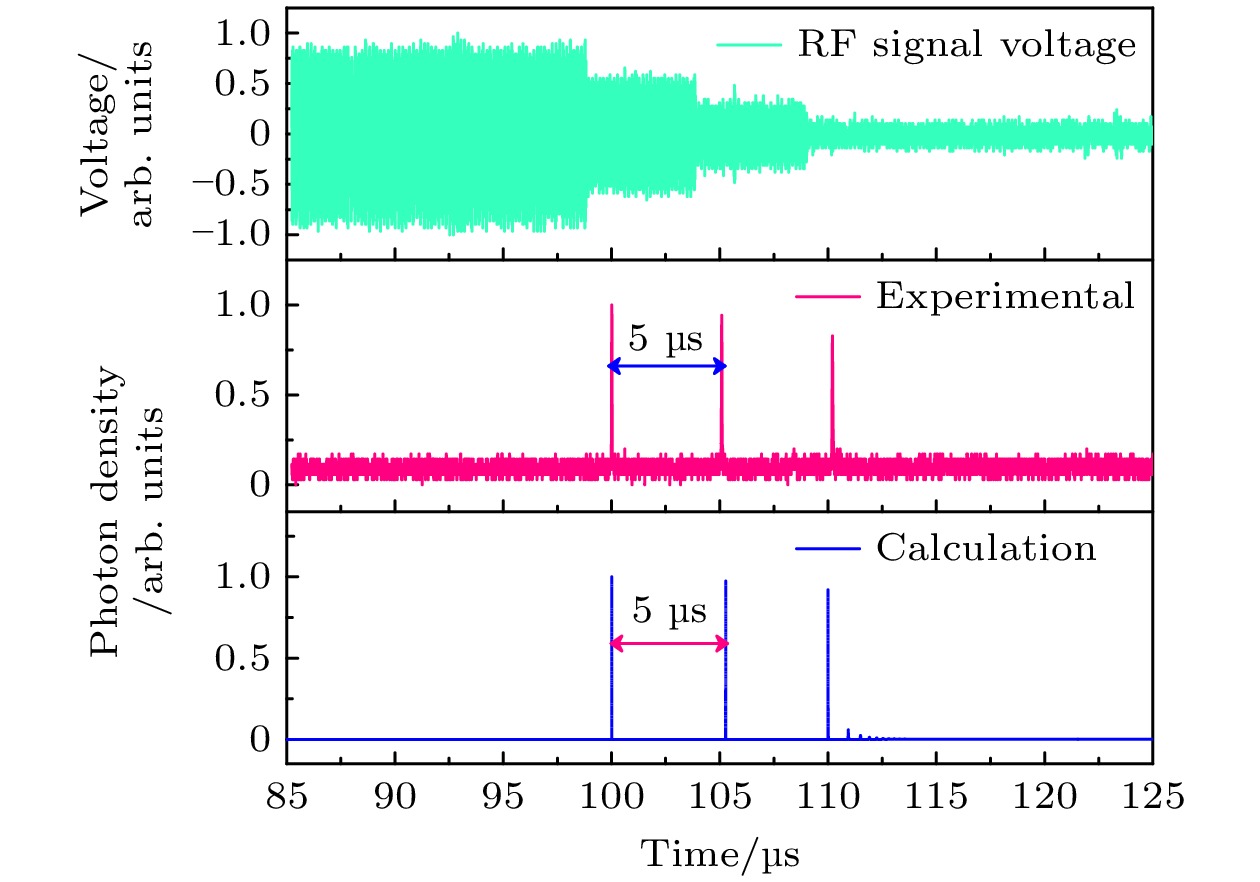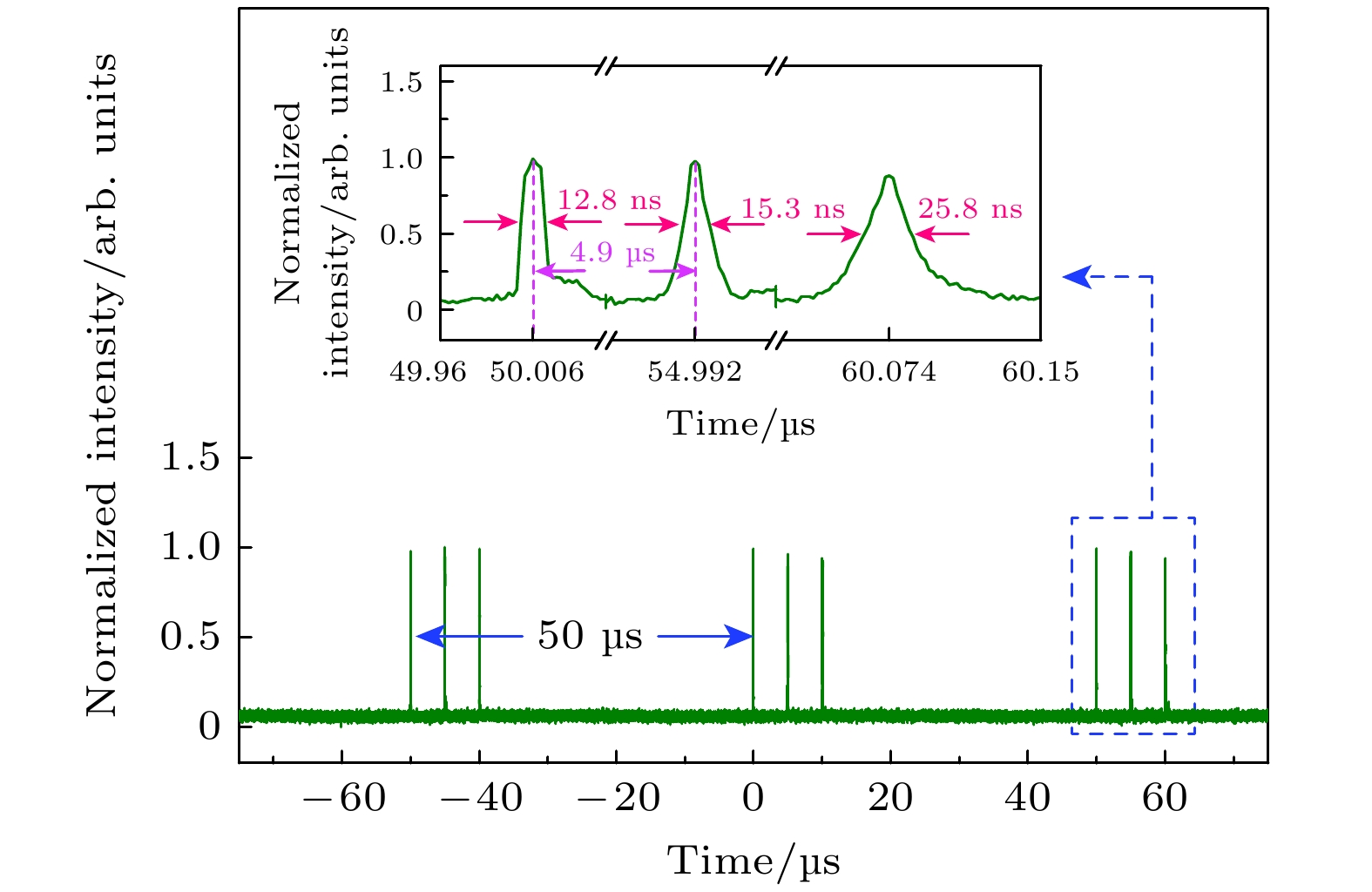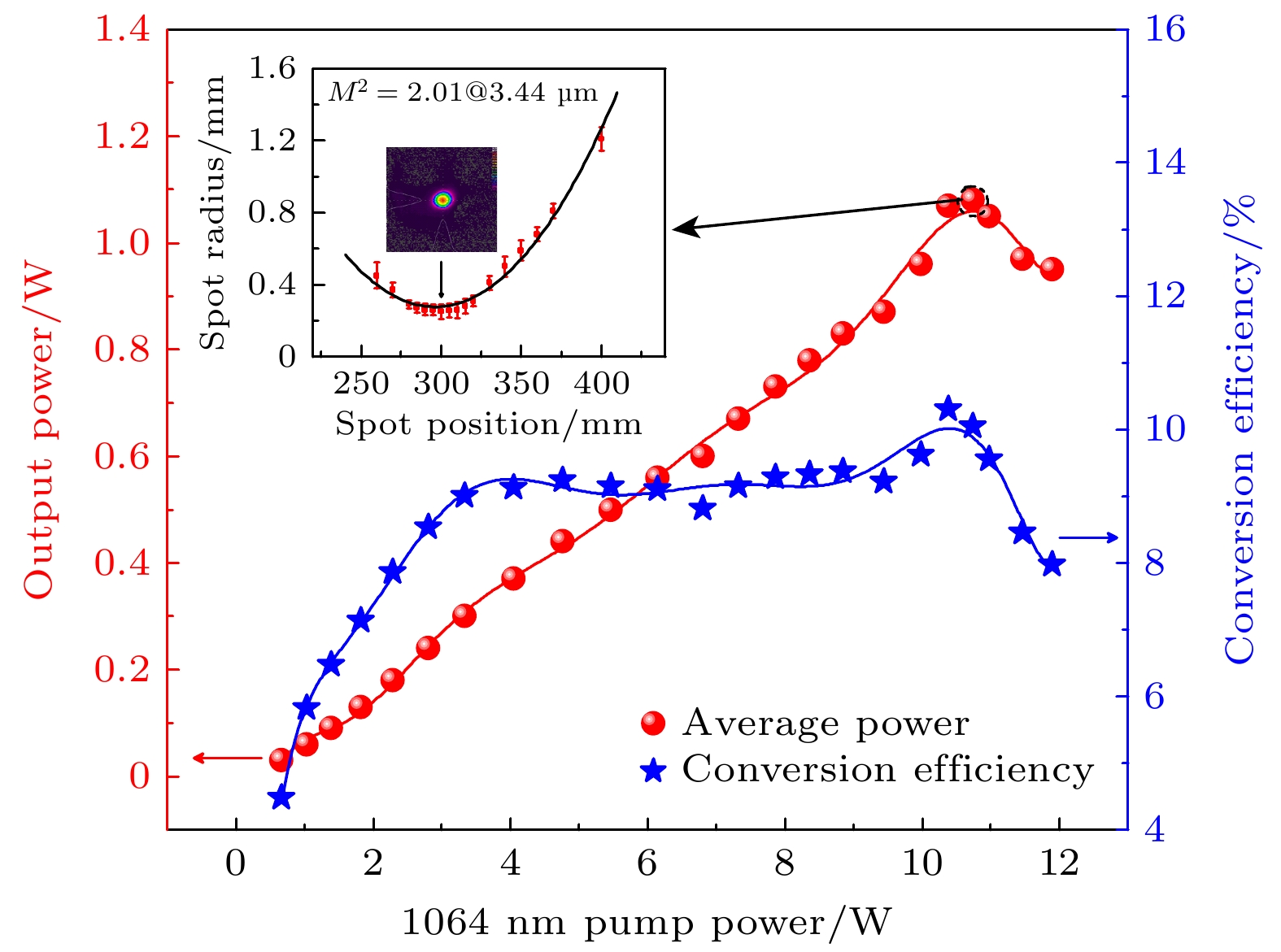-
3.4 μm mid-infrared pulse train laser generates the characteristic spectral lines of absorption peaks of CH4, NO2 and other molecules. Its pulse train working mode can increase the signal-to-noise ratio of laser detection echo signal. It has broad application prospects in radar detection, environmental monitoring, spectral analysis and other fields, which has aroused great interest of scientists. Compared with the traditional intra-cavity control method, the step Q-switching method has the advantages of simple structure, high energy utilization rate and accurate control. Therefore, in this paper, both the theoretical study and the experimental study of a 3.4 μm mid-infrared pulse train laser pumped by a step-type acousto-optic Q-switched external cavity in MgO:PPLN optical parametric oscillator are carried out. The theoretical model of fundamental frequency step acousto-optic Q-switching is established. The change trends of photon number density at different step intervals are simulated. The optimal trigger time of step signal required for step acousto-optic Q-switching is obtained. The possibility of obtaining pulse train laser output by step acousto-optic Q-switching is determined. In the simulation, the single pulse envelope contains 3 sub-pulse train waveforms. The pulse width of the sub-pulse in the pulse envelope gradually increases, the sub-pulse interval is 5 μs, and the pulse envelope repetition frequency is 20 kHz. At the same time, the optimal trigger times for the step signal are obtained to be 16.00, 21.00, 26.00, 50.00 μs. The mid-infrared pulse train laser experiment of step acousto-optic Q-switched external cavity pumped MgO:PPLN optical parametric oscillator is carried out, and the 3.4 μm mid-infrared pulse train laser output containing three sub-pulses in a single pulse envelope is obtained. The sub-pulse interval is 5 μs, the narrowest pulse width is 12.8 ns, and the pulse envelope repetition frequency is 20 kHz, when the maximum average output power is 1.08 W, the maximum optical-to-optical conversion efficiency of 1064 nm fundamental light and 3.4 μm parametric light is 10.05%, and the beam quality factor
$M^2$ is 2.01. The output position of the sub pulses in each repetition period in the experiment is basically consistent with the simulation result, and it is found in both simulation and experiment that the width of the sub pulses within each pulse envelope gradually increases. The experimental results show that 3.4 μm mid-infrared pulse train laser output can be obtained by using step AOQS combined with OPO. This innovative method provides theoretical and technical support for detecting atmospheric pollutant concentration by using mid-infrared pulse train laser.-
Keywords:
- mid-infrared laser /
- pulse train /
- step acousto-optic Q-switching /
- optical parametric oscillation
[1] Muraviev A, Smolski V, Loparo Z, Vodopyanov K 2018 Nat. Photonics 12 209
 Google Scholar
Google Scholar
[2] Vodopyanov K L 2020 Laser-based Mid-infrared Sources and Applications (Hoboken: John Wiley & Sons) pp1–5
[3] Zhao Z M, Wu B, Wang X S, Pan Z H, Liu Z J, Zhang P Q, Shen X, Nie Q H, Dai S X, Wang R P 2017 Laser Photonics Rev. 11 1700005
 Google Scholar
Google Scholar
[4] Koroglu B, Neupane S, Pryor O, Peale R E, Vasu S S 2018 J. Quantum Spectrosc. Radiat. Transfer 206 36
 Google Scholar
Google Scholar
[5] Walsh B M, Lee H R, Barnes N P 2016 J. Lumin. 169 400
 Google Scholar
Google Scholar
[6] Ma H L, Sun M G, Zhan S B, Zhang Q L, Zha S L, Wang G S, Liu K, Yi M F, Cao Z S 2020 Spectrochim. Acta, Part A 226 117605
 Google Scholar
Google Scholar
[7] Petrov K, Waltman S, Dlugokencky E, Arbore M, Fejer M, Tittel F, Hollberg L W 1997 Appl. Phys. B 64 567
 Google Scholar
Google Scholar
[8] Nikodem M, Krzempek K, Dudzik G, Abramski K 2018 Opt. Express 26 21843
 Google Scholar
Google Scholar
[9] Veerabuthiran S, Razdan A K, Jindal M K, Sharma R K, Sagar V 2015 Opt. Laser Technol. 73 1
[10] Refaat T F, Singh U N, Petros M, Remus R, Yu J 2015 Appl. Opt. 54 7240
 Google Scholar
Google Scholar
[11] Refaat T F, Singh U N, Yu J, Petros M, Ismail S, Kavaya M J, Davis K J 2015 Appl. Opt. 54 1387
 Google Scholar
Google Scholar
[12] Shayeganrad G 2018 Opt. Laser Eng. 111 80
 Google Scholar
Google Scholar
[13] Koch G J, Barnes B W, Petros M, Beyon J Y, Amzajerdian F, Yu J, Davis R E, Ismail S, Vay S, Kavaya M J 2004 Appl. Opt. 43 5092
 Google Scholar
Google Scholar
[14] Li X L, Luo P 2019 IEEE Sens. J. 19 6270
 Google Scholar
Google Scholar
[15] Elkhazraji A, Shakfa M K, Abualsaud N, Mhanna M, Sy M, Marangoni M, Farooq A 2023 Appl. Opt. 62 A46
 Google Scholar
Google Scholar
[16] Seddon A B 2013 Phys. Status Solidi B 250 1020
 Google Scholar
Google Scholar
[17] Gong Y, Bu L B, Yang B, Mustafa F 2020 Sensors 20 2211
 Google Scholar
Google Scholar
[18] Pan R C, Retzer U, Werblinski T, Slipchenko M N, Meyer T R, Zigan L, Will S 2018 Opt. Lett. 43 1191
 Google Scholar
Google Scholar
[19] Thurow B, Jiang N B, Samimy M, Lempert W 2004 Appl. Opt. 43 5064
 Google Scholar
Google Scholar
[20] Wu W T, Li X D, Yan R P, Zhou Y P, Ma Y F, Fan R W, Dong Z W, Chen D Y 2017 Opt. Express 25 26875
 Google Scholar
Google Scholar
[21] Li X D, Xu H B, Yan R P, Jiang Y G, Fan R W, Dong Z W, Chen D Y 2021 Optik 228 165789
 Google Scholar
Google Scholar
[22] Slipchenko M N, Miller J D, Roy S, Gord J R, Danczyk S A, Meyer T R 2012 Opt. Lett. 37 1346
 Google Scholar
Google Scholar
[23] Mao J, Wang C, Hong T X, Yu Y J 2021 Chin. Opt. Lett. 19 071404
 Google Scholar
Google Scholar
[24] Degnan J J 1989 IEEE J. Quantum Electron. 25 214
 Google Scholar
Google Scholar
[25] Pinnow D 1970 IEEE J. Quantum Electronics 6 223
 Google Scholar
Google Scholar
[26] Tucker A, Birnbaum M, Fincher C, Erler J 1977 J. Appl. Phys. 48 4907
 Google Scholar
Google Scholar
[27] Sun D H, Zhang Y W, Wang D Z, Wei S, Liu X Y, Pang J B, Geng D Q, Sang Y H, Liu H 2020 Light: Sci. Appl. 9 197
[28] 于永吉, 陈薪羽, 成丽波, 王超, 吴春婷, 董渊, 李述涛, 金光勇 2015 64 224215
 Google Scholar
Google Scholar
Yu Y J, Chen X Y, Cheng L B, Wang C, Wu C T, Dong Y, Li S T, Jin G Y 2015 Acta Phys. Sin. 64 224215
 Google Scholar
Google Scholar
-
图 2 反转粒子数密度、光子数密度随时间变化情况 (a) 反转粒子数密度随时间变化; (b) 光子数密度随时间变化; (c) 第一个周期内反转粒子数密度随时间变化; (d) 第一个周期内光子数密度随时间变化; (e) t3—t4时反转粒子数密度随时间变化; (f) t3—t4时光子数密度随时间变化
Figure 2. Inversion population density and photon density change with time: (a) Inversion population density changing over time; (b) photon number density changing over time; (c) number density of inversion particles changes with time in the first period; (d) photon number density changes with time during the first cycle; (e) number density of inversion particles changes with time at t3–t4; (f) number density of photons changes with time at t3–t4.
表 1 台阶AOQS速率方程模拟主要参数
Table 1. Simulating key parameters of step AOQS equation.
表 2 镜片M1, M2, M3, M4镀膜情况
Table 2. Coating status of lenses M1, M2, M3, and M4.
光学元件 材质 膜系参数 M1 K9 HT@808 nm, HR@1064 nm M2 K9 HR@808 nm,
T = 50%@1064 nmM3 CaF2 HR@1.4—1.85 μm,
HR@2.6—4.3 μm,
HT@1060—1095 nmM4 CaF2 HR@1064 nm,
HR@1.4—1.7 μm,
HT@3.1—4.2 μm -
[1] Muraviev A, Smolski V, Loparo Z, Vodopyanov K 2018 Nat. Photonics 12 209
 Google Scholar
Google Scholar
[2] Vodopyanov K L 2020 Laser-based Mid-infrared Sources and Applications (Hoboken: John Wiley & Sons) pp1–5
[3] Zhao Z M, Wu B, Wang X S, Pan Z H, Liu Z J, Zhang P Q, Shen X, Nie Q H, Dai S X, Wang R P 2017 Laser Photonics Rev. 11 1700005
 Google Scholar
Google Scholar
[4] Koroglu B, Neupane S, Pryor O, Peale R E, Vasu S S 2018 J. Quantum Spectrosc. Radiat. Transfer 206 36
 Google Scholar
Google Scholar
[5] Walsh B M, Lee H R, Barnes N P 2016 J. Lumin. 169 400
 Google Scholar
Google Scholar
[6] Ma H L, Sun M G, Zhan S B, Zhang Q L, Zha S L, Wang G S, Liu K, Yi M F, Cao Z S 2020 Spectrochim. Acta, Part A 226 117605
 Google Scholar
Google Scholar
[7] Petrov K, Waltman S, Dlugokencky E, Arbore M, Fejer M, Tittel F, Hollberg L W 1997 Appl. Phys. B 64 567
 Google Scholar
Google Scholar
[8] Nikodem M, Krzempek K, Dudzik G, Abramski K 2018 Opt. Express 26 21843
 Google Scholar
Google Scholar
[9] Veerabuthiran S, Razdan A K, Jindal M K, Sharma R K, Sagar V 2015 Opt. Laser Technol. 73 1
[10] Refaat T F, Singh U N, Petros M, Remus R, Yu J 2015 Appl. Opt. 54 7240
 Google Scholar
Google Scholar
[11] Refaat T F, Singh U N, Yu J, Petros M, Ismail S, Kavaya M J, Davis K J 2015 Appl. Opt. 54 1387
 Google Scholar
Google Scholar
[12] Shayeganrad G 2018 Opt. Laser Eng. 111 80
 Google Scholar
Google Scholar
[13] Koch G J, Barnes B W, Petros M, Beyon J Y, Amzajerdian F, Yu J, Davis R E, Ismail S, Vay S, Kavaya M J 2004 Appl. Opt. 43 5092
 Google Scholar
Google Scholar
[14] Li X L, Luo P 2019 IEEE Sens. J. 19 6270
 Google Scholar
Google Scholar
[15] Elkhazraji A, Shakfa M K, Abualsaud N, Mhanna M, Sy M, Marangoni M, Farooq A 2023 Appl. Opt. 62 A46
 Google Scholar
Google Scholar
[16] Seddon A B 2013 Phys. Status Solidi B 250 1020
 Google Scholar
Google Scholar
[17] Gong Y, Bu L B, Yang B, Mustafa F 2020 Sensors 20 2211
 Google Scholar
Google Scholar
[18] Pan R C, Retzer U, Werblinski T, Slipchenko M N, Meyer T R, Zigan L, Will S 2018 Opt. Lett. 43 1191
 Google Scholar
Google Scholar
[19] Thurow B, Jiang N B, Samimy M, Lempert W 2004 Appl. Opt. 43 5064
 Google Scholar
Google Scholar
[20] Wu W T, Li X D, Yan R P, Zhou Y P, Ma Y F, Fan R W, Dong Z W, Chen D Y 2017 Opt. Express 25 26875
 Google Scholar
Google Scholar
[21] Li X D, Xu H B, Yan R P, Jiang Y G, Fan R W, Dong Z W, Chen D Y 2021 Optik 228 165789
 Google Scholar
Google Scholar
[22] Slipchenko M N, Miller J D, Roy S, Gord J R, Danczyk S A, Meyer T R 2012 Opt. Lett. 37 1346
 Google Scholar
Google Scholar
[23] Mao J, Wang C, Hong T X, Yu Y J 2021 Chin. Opt. Lett. 19 071404
 Google Scholar
Google Scholar
[24] Degnan J J 1989 IEEE J. Quantum Electron. 25 214
 Google Scholar
Google Scholar
[25] Pinnow D 1970 IEEE J. Quantum Electronics 6 223
 Google Scholar
Google Scholar
[26] Tucker A, Birnbaum M, Fincher C, Erler J 1977 J. Appl. Phys. 48 4907
 Google Scholar
Google Scholar
[27] Sun D H, Zhang Y W, Wang D Z, Wei S, Liu X Y, Pang J B, Geng D Q, Sang Y H, Liu H 2020 Light: Sci. Appl. 9 197
[28] 于永吉, 陈薪羽, 成丽波, 王超, 吴春婷, 董渊, 李述涛, 金光勇 2015 64 224215
 Google Scholar
Google Scholar
Yu Y J, Chen X Y, Cheng L B, Wang C, Wu C T, Dong Y, Li S T, Jin G Y 2015 Acta Phys. Sin. 64 224215
 Google Scholar
Google Scholar
Catalog
Metrics
- Abstract views: 3158
- PDF Downloads: 55
- Cited By: 0
















 DownLoad:
DownLoad:







